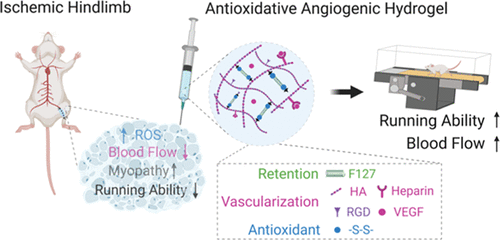当前位置:
X-MOL 学术
›
ACS Appl. Mater. Interfaces
›
论文详情
Our official English website, www.x-mol.net, welcomes your
feedback! (Note: you will need to create a separate account there.)
Antioxidative and Angiogenic Hyaluronic Acid-Based Hydrogel for the Treatment of Peripheral Artery Disease
ACS Applied Materials & Interfaces ( IF 8.3 ) Pub Date : 2021-09-14 , DOI: 10.1021/acsami.1c11349 Cui Li 1, 2 , Fujiao Nie 2, 3 , Xiaoyan Liu 2 , Meng Chen 2 , David Chi 4 , Shuai Li 5 , Iraklis I Pipinos 5 , Xiaowei Li 2, 4
ACS Applied Materials & Interfaces ( IF 8.3 ) Pub Date : 2021-09-14 , DOI: 10.1021/acsami.1c11349 Cui Li 1, 2 , Fujiao Nie 2, 3 , Xiaoyan Liu 2 , Meng Chen 2 , David Chi 4 , Shuai Li 5 , Iraklis I Pipinos 5 , Xiaowei Li 2, 4
Affiliation

|
Peripheral arterial disease (PAD) is a progressive atherosclerotic disorder characterized by blockages of the arteries supplying the lower extremities. Ischemia initiates oxidative damage and mitochondrial dysfunction in the legs of PAD patients, causing injury to the tissues of the leg, significant decline in walking performance, leg pain while walking, and in the most severe cases, nonhealing ulcers and gangrene. Current clinical trials based on cells/stem cells, the trophic factor, or gene therapy systems have shown some promising results for the treatment of PAD. Biomaterial matrices have been explored in animal models of PAD to enhance these therapies. However, current biomaterial approaches have not fully met the essential requirements for minimally invasive intramuscular delivery to the leg. Ideally, a biomaterial should present properties to ameliorate oxidative stress/damage and failure of angiogenesis. Recently, we have created a thermosensitive hyaluronic acid (HA) hydrogel with antioxidant capacity and skeletal muscle-matching stiffness. Here, we further optimized HA hydrogels with the cell adhesion peptide RGD to facilitate the development of vascular-like structures in vitro. The optimized HA hydrogel reduced intracellular reactive oxygen species levels and preserved vascular-like structures against H2O2-induced damage in vitro. HA hydrogels also provided prolonged release of the vascular endothelial growth factor (VEGF). After injection into rat ischemic hindlimb muscles, this VEGF-releasing hydrogel reduced lipid oxidation, regulated oxidative-related genes, enhanced local blood flow in the muscle, and improved running capacity of the treated rats. Our HA hydrogel system holds great potential for the treatment of the ischemic legs of patients with PAD.
中文翻译:

用于治疗外周动脉疾病的抗氧化和血管生成透明质酸水凝胶
外周动脉疾病 (PAD) 是一种进行性动脉粥样硬化性疾病,其特征是供应下肢的动脉阻塞。缺血会引发 PAD 患者腿部的氧化损伤和线粒体功能障碍,导致腿部组织损伤、行走能力显着下降、行走时腿部疼痛,在最严重的情况下,还会出现不愈合的溃疡和坏疽。目前基于细胞/干细胞、营养因子或基因治疗系统的临床试验已经显示出一些治疗 PAD 的有希望的结果。已经在 PAD 的动物模型中探索了生物材料基质以增强这些疗法。然而,目前的生物材料方法尚未完全满足对腿部进行微创肌肉注射的基本要求。理想情况下,生物材料应具有改善氧化应激/损伤和血管生成失败的特性。最近,我们创造了一种具有抗氧化能力和骨骼肌匹配刚度的热敏透明质酸 (HA) 水凝胶。在这里,我们进一步优化了具有细胞粘附肽 RGD 的 HA 水凝胶,以促进血管样结构的发展体外。优化的 HA 水凝胶降低了细胞内活性氧物质水平,并在体外保留了抗 H 2 O 2诱导的损伤的血管样结构。HA 水凝胶还提供血管内皮生长因子 (VEGF) 的延长释放。注射到大鼠缺血性后肢肌肉后,这种释放 VEGF 的水凝胶减少了脂质氧化,调节了氧化相关基因,增强了肌肉中的局部血流,并提高了治疗大鼠的跑步能力。我们的 HA 水凝胶系统在治疗 PAD 患者的缺血性腿方面具有巨大潜力。
更新日期:2021-09-29
中文翻译:

用于治疗外周动脉疾病的抗氧化和血管生成透明质酸水凝胶
外周动脉疾病 (PAD) 是一种进行性动脉粥样硬化性疾病,其特征是供应下肢的动脉阻塞。缺血会引发 PAD 患者腿部的氧化损伤和线粒体功能障碍,导致腿部组织损伤、行走能力显着下降、行走时腿部疼痛,在最严重的情况下,还会出现不愈合的溃疡和坏疽。目前基于细胞/干细胞、营养因子或基因治疗系统的临床试验已经显示出一些治疗 PAD 的有希望的结果。已经在 PAD 的动物模型中探索了生物材料基质以增强这些疗法。然而,目前的生物材料方法尚未完全满足对腿部进行微创肌肉注射的基本要求。理想情况下,生物材料应具有改善氧化应激/损伤和血管生成失败的特性。最近,我们创造了一种具有抗氧化能力和骨骼肌匹配刚度的热敏透明质酸 (HA) 水凝胶。在这里,我们进一步优化了具有细胞粘附肽 RGD 的 HA 水凝胶,以促进血管样结构的发展体外。优化的 HA 水凝胶降低了细胞内活性氧物质水平,并在体外保留了抗 H 2 O 2诱导的损伤的血管样结构。HA 水凝胶还提供血管内皮生长因子 (VEGF) 的延长释放。注射到大鼠缺血性后肢肌肉后,这种释放 VEGF 的水凝胶减少了脂质氧化,调节了氧化相关基因,增强了肌肉中的局部血流,并提高了治疗大鼠的跑步能力。我们的 HA 水凝胶系统在治疗 PAD 患者的缺血性腿方面具有巨大潜力。











































 京公网安备 11010802027423号
京公网安备 11010802027423号